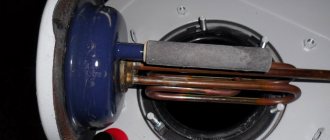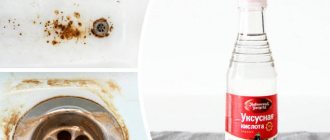Cleaning the carburetor is a mandatory procedure that must be carried out at least once a year or whenever this part becomes dirty. Nowadays, most cars have an injection system. But you can also find those that work with carburetor engines. Carburetors have weak technical characteristics. How can we explain their popularity? The ability to repair and maintain them at home. To do this you will need a minimum set of tools and skills.
Car carburetor design
For normal operation, the engine must receive a fuel-air mixture.
The regulation and supply of the mixture is entrusted to the carburetor, which controls mixing in strict proportions. That is, a carburetor is a device that creates a ready-made mixture of gasoline and air. He supplies it in certain doses to the engine. The node consists of the following elements:
- two chambers separated by a partition;
- jets and channels;
- float with axle;
- needle valve;
- throttle valve;
- Venturi tubes.
This carburetor is called a float carburetor. The principle of its operation is simple: a special line is connected to one of the chambers, through which gasoline is supplied directly from the tank. The next portion of fuel gets inside only after the float with the shut-off valve drops. When the chamber is full, the needle shuts off the fuel supply.
The main jet acts as a calibrator. Through it, gasoline enters the atomizer, then into the mixing chamber. Here the process of mixing fuel with air entering through the throttle valve occurs.
A carburetor is a complex device capable of recognizing several operating modes of an internal combustion engine:
- maximum loads;
- idling;
- average speed;
- cold work.
It should react differently to each mode. In one case, enrich gasoline with oxygen, in the other, minimize the supply of fuel. Therefore, every part of such a complex device must be in good working order and clearly calibrated.
Carburetor care, replacement and repair
Sometimes, in order to bring the carburetor for a walk-behind tractor into a stable, working condition, adjustment is not enough, repair or replacement is necessary.
It happens that the carburetor air damper does not close completely. To eliminate this problem, you should monitor the operation of the drive. If jams are found, remove them. Moreover, given that the carburetor supplies fuel and, therefore, drives the walk-behind tractor itself, you should carefully monitor the condition of this part and properly care for it.
To avoid serious carburetor damage, you must constantly monitor its operation. In addition to adjusting the idle speed, you need to regularly clean the carburetor and replace worn parts. Since the carburetor interacts with the fuel mixture and air, the cause of its contamination may lie in either the first or the second source.
To make the degree of contamination significantly less, you can use filters, which should be cleaned and changed as needed. In addition, the quality of the fuel also has a significant impact. Poor quality flammable fluid can lead to damage to parts and premature replacement. If the need arises, a carburetor for a walk-behind tractor can be purchased at the automobile market or store. Its replacement, adjustment and cleaning are also carried out by specialists.
The Mole walk-behind tractor is a small-scale mechanization tool designed directly for working with the ground. Its great popularity in our country is due to the fact that, despite its low cost, it shows quite good technical characteristics.
However, in order for this walk-behind tractor to continue to work correctly, it must be periodically maintained.
These measures can significantly extend the operational life of the unit, without losing its performance qualities.
One type of such maintenance is carburetor adjustment , which must be carried out immediately after the end of the first season of operation.
Carburetor cleaning products
| Name of carburetor cleaner | Pros + | Minuses - | Price at the time of writing |
| MANNOL 9970 Carburetor Cleaner | Cleans very well and is convenient to use. Read the reviews: 1 → 2 → 3 → 4 → 5 → 6 → 7 → 8 | When stored, the tube taped to the cylinder constantly tends to get lost. | 150 rub. for a volume of 400 ml. |
| XADO JET100 ULTRA | Probably one of the best penetrating lubricants and its lubricating properties are excellent, and it also has a pleasant smell. Read the reviews: 1 → 2 → 3 → 4 → 5 → 6 → 7 | It ends quickly. Small volume. | 342 rub. for a volume of 250 ml. |
| Hi-Gear Carburetor Cleaner | Cleans perfectly. Effectively restores carburetor characteristics without disassembly. Read the reviews: 1 → 2 → 3 → 4 → 5 | The bottle is enough for 2 times. Bad smell. Toxic. | 522 rub. for a volume of 510 ml. |
| Liqui Moly Vergaser-Aussen-Reiniger | Gently cleans the fuel system. Using this composition, you can remove not only carbon deposits and tar deposits from the surface, but also clean channels and throttle valves. Read reviews: 1 | A little expensive. | 527 rub. for a volume of 400 ml. |
| Carburetor cleaner 3ton | Quality, price, carburetor cleaning 5+ Read reviews: 1 | Not found. | 114 rub. for volume 354 ml |
What engine oil to use in a car
Who is too lazy to read: here is a good video review of carburetor flushes
I will also be happy to hear your feedback on the article and possibly correct any inaccuracies in the description of the carburetor cleaning process, and in general, I’m interested in any of your opinions!
Why and when do you need to clean the carburetor?
How to check injectors at home
Like any metering system, carburetor injection is located under the hood of the car, thereby constantly interacting with fuel and hot air. Since it is a mechanical device with some moving parts located outside, it is prone to getting dirty. This could be dust, soot, dirt or motor oil that settles both outside and inside the device.
Carburetor cleaner is needed for preventative cleaning, as well as in the presence of the following car symptoms:
- increased fuel consumption and reduced power;
- it is impossible to start a cold or hot engine;
- high level of emissions of harmful substances and smoke;
- nothing happens when I press the accelerator pedal.
These car symptoms can be caused by other reasons, but the most common are factors associated with a dirty carburetor.
Instructions for use of aerosol cleaner
A special substance is placed in a metal can weighing 400 g. The cleaning aerosol is under pressure. The kit includes a dispenser and a nozzle in the form of a tube for penetration into hard-to-reach places.
When spraying the spray on the surface of all carburetor parts, fire safety precautions must be observed. The product should not be used in rooms with poor ventilation or near open fire. When carrying out work, it is necessary to protect your eyes and hands and avoid contact of caustic substances with mucous membranes or skin.
Why and when you need to clean the carburetor
What kind of oil to fill in a VAZ 2107 carburetor
Let's start with the fact that carburetor injection, like any other metering system in the general power supply circuit of an internal combustion engine, is located in the engine compartment and constantly interacts with the components of the fuel mixture (fuel and air). Also, a carburetor is a mechanical device that consists of a number of moving parts. Some elements are open and subject to significant contamination along with the general contamination of the engine compartment.
During the operation of the car, dust and dirt settle on the carburetor, which mixes with particles of engine oil; the temperature difference in the engine compartment (heating from the internal combustion engine and subsequent cooling) also has its effect. In other words, the carburetor becomes intensively contaminated both outside and inside. Films of gasoline and motor oil settle on carburetor flaps, on the surfaces of drives, in channels and other elements, dust and soot accumulate, and deposits form.
If the pollution is strong, then the following symptoms occur:
- power decreases and fuel consumption increases noticeably;
- smoke, increased toxicity of exhaust gases;
- difficulty starting a cold and/or hot engine;
- unstable operation at idle, the speed fluctuates, the engine troits;
- failures during acceleration, slow response to the gas pedal, etc.
Please note that these symptoms may also occur for other reasons. To eliminate possible problems, the motor requires diagnostics. In parallel with this, on carburetor cars, the metering device is still a common culprit. If this is the case, then you need to clean the carburetor, that is, you will need to use special equipment. To effectively remove contaminants, you must use a high-quality cleaner. In such a situation, you can either deliver the car to a service station or clean the carburetor yourself, deciding on the choice of cleaning agent.
Other washing methods
Sometimes it happens that there is no special means for cleaning the working unit nearby.
In such cases, solvent No. 646 can help. Although you shouldn’t rely too much on it. The effectiveness of this cleaning method is quite low, and it only allows for a short period of time to remove contaminants from the surface of the carburetor. The proper operation of this part depends not only on the frequency of its cleaning, but also on the product used. In order not to make a mistake in choosing this product, you need to carefully familiarize yourself with its composition and properties in the store. It is imperative to take into account the activity of using the cleaning agent. We should also not forget that all elements of the fuel system require regular cleaning. To ensure proper operation of the carburetor, it is recommended to clean it of dirt every 10-15 thousand km.
Trouble-free operation of a vehicle depends on many components, not least of which is the carburetor. Every car owner should regularly check its condition. This is especially true for those who use low-quality fuel. This factor increases the likelihood of clogging by an order of magnitude. But you can avoid the negative consequences caused by a dirty carburetor if you clean it regularly.
Every car owner can handle this task with his own hands, so you don’t even have to turn to specialists for help. When disassembling this power unit, it is only necessary to remember the location of the main parts. But first you need to understand what is the best way to flush the carburetor.
This must be a special composition designed to remove contaminants from the internal and external surfaces of the working unit. It is not recommended to save on the purchase of cleaning fluid, otherwise this may soon result in new, even more serious problems for the car owner, the elimination of which will require not only more time, but also financial costs.
Most new gasoline cars are equipped with fuel injection systems. However, on our roads there are a sufficient number of cars with carburetor engines. They often have weaker performance characteristics, but remain popular due to their high self-repairability.
Most systems in carburetor cars can be put in order in a garage with a minimum set of auxiliary tools. The list of available operations also includes carburetor cleaning.
Cleaning procedure without dismantling the carb
Here's how it's done.
- The VF housing is removed, the EM valve and the plug responsible for the XX mode are unscrewed.
- After the internal elements of the carb become visible, it is necessary to apply a stream of aerosol agent to flush all lines of the XX system and the first chamber.
- At the same time, spray the aerosol spray into the second chamber and also treat the air jet channels of the main dosing system.
It is important to understand that correct application of the spray also involves treating camera mirrors and diffusers. Cleaning the valves is mandatory
A thin tube is specially provided for this purpose, allowing you to clean the most difficult places.
It is equally important to process the damper drive lever, as well as other components and simple places of the control mechanisms. This will ensure better controllability and normalize the functioning of the carb.
Cleaning does not end with the spray application stage.
- You need to wait five minutes. During this time, the product will soften the deposits and wash away the dirt.
- Next, you need to start the engine, and then pull out the choke, which will allow the engine to operate at idle speed without an EV valve. It is recommended to gas it a little more for a better effect.
By the way, some drivers do this. The speed of the power plant is forcibly increased in the idle mode, then an additional aerosol is sprayed inside the mixing device. In their opinion, this significantly improves the cleanliness of the carburetor.
The procedure can be repeated two or three times. At the final stage, everything must be put back together, the EM and other elements that had to be dismantled must be put back in place. Also, don’t forget to push the choke back into place.
Interesting point. It is recommended to tighten the valve while the engine is running. This must be done extremely carefully, first carrying out the process with your hands, and at the final stage, apply the force of an open-end wrench. You should turn the EM key no more than a quarter turn, as otherwise you can overdo it. In a word, you need to make sure that after removing the wiring from the EV, the engine begins to stall.
There is another cleaning method. It is much shorter than the above method. Often used by experienced motorists.
- Swap the two armored wires from the spark plugs. Replace the current cable of the first cylinder of the power plant in place of the cable of the fourth cylinder, and vice versa.
- Start the engine. It will begin to “sneeze” and “shoot”, but this will allow all impurities to be knocked out of the clogged carburetor channels.
During the process of starting an internal combustion engine with armored wires thrown in places, the consistency of ignition is disrupted. The pressure is created from the untimely ignition of fuel assemblies in the combustion chambers. In this manner, you can clean the SWR (carburetor) easily and simply, but you should not leave the engine running in this mode for a long time. In addition, this method is recommended as an emergency, and it is best to carry it out only if you need to drive a car to a service center.
On a note. One way or another, after such a shake-up of the system, the carburetor will still need to be cleaned, because debris from the jets will fall back into the chamber. If this is not done, the channels will become clogged with debris again after some time.
However, it is not always possible to clean the carburetor without removing it. Some models become so dirty during operation that debris accumulates and gets compacted in the float chamber, channels and other areas of the carburetor. It is especially unpleasant when the air supply nozzles become clogged, and the car’s fuel consumption increases significantly.
A carburetor is considered a complex device. Its details are selected with jeweler's precision, there are many of them. To remove all contaminants, washing alone will clearly not be enough. Therefore, carburetor manufacturers use more effective methods. For example, the jets are blown with compressed air, and before that they are soaked in a special liquid.
- Absolutely legal (Article 12.2.4).
- Hides from photo and video recording.
- Installs independently in 2 minutes.
- Invisible to the human eye, does not deteriorate due to weather.
- 2 year warranty
How to adjust the carburetor on a walk-behind tractor?
In equipment from different manufacturers, the carburetor of a walk-behind tractor is adjusted in different ways. Below we will look at how to correctly and accurately configure fuel units in agricultural implements of different brands.
Walk-behind tractors of the Cascade brand
Most branded models produced by the Cascade brand include KMB-5 carburetors.
To configure this fuel unit, you must:
- Drain any remaining fuel from the factory float chamber;
- Open the fitting and let air inside the fuel unit;
- Adjust the position of the throttle valve in such a way that a neat 2 mm gap gradually forms between it and the air duct located under the valve;
- Tighten the bolts responsible for adjusting the fuel supply;
- Start slowly unscrewing the screws one by one until the speed of the power unit decreases;
- Slowly screw the screws back in one at a time.
As a result, the user will eliminate failures during engine operation and reduce the fuel consumption.
Motoblocks Neva MB-1 and Neva MB-2
Most often, the factory design of the MB-1 and MB-2 models of the Neva brand includes K-45 carburetors or their modifications. The order in which they are configured will be the same.
For factory fuel units of the K-45R type, the adjustment should be performed as follows:
- First, you need to completely screw in the factory screws intended for manually adjusting the intensity of the maximum and minimum gas supply;
- Next you need to unscrew each of these steel screws one by one;
- Next, the operator will need to start and fully warm up the power unit of the walk-behind tractor used;
- After this, you will need to adjust the operation of a fully serviceable engine at the lowest possible idle speed;
- If necessary, repeat the previous 2 steps. This must be done until the operation of the power unit at the minimum possible speed of standard idle becomes as stable as possible;
- If after several repetitions the result cannot be achieved, then the screw for adjusting and setting the full throttle will need to be unscrewed and screwed back. This procedure will need to be repeated until the motor resumes operation.
If numerous manipulations with the adjustment screw and full throttle setting do not bring the desired result, then you will need to remove and inspect the carburetor. If necessary, it must be repaired or thoroughly cleaned.
Motoblocks Agro
To set up a standard fuel unit in the design of models of this brand you need:
- Fully screw in the screws that are initially responsible for adjusting engine operation in low and full throttle modes. Immediately after this, each of the screws must be unscrewed 1.5 turns;
- Start the power unit and wait 10 minutes for it to warm up completely;
- Adjust the continuous operation of the built-in engine of the existing walk-behind tractor directly at the minimum permissible idle speed. The operator must begin to turn the screw for self-adjusting the position of the standard throttle valve alternately in different directions immediately until the operation of the internal combustion engine is as quiet and stable as possible;
- Adjust the amount of fuel and intake air that is supplied to the carburetor's metal float chamber and engine cylinder. Gradually tightening the screw will enrich the fuel with the intake air in the factory metal float chamber. Unscrewing it slowly, on the contrary, will increase the amount of air that is supplied directly to the cylinder. The video will tell you more about setting up the carburetor of the Agro walk-behind tractor.
It is necessary to adjust the carburetor of the Agro walk-behind tractor when extraneous sounds appear from the engine, as well as when the volume of fuel consumed and the exhaust gases produced increase. Timely adjustment of the unit with your own hands will improve the quality of the fuel, which will lead to increased power and efficiency of the power unit.
Motoblocks MTZ-09
It is necessary to adjust the carburetor of a Belarus brand walk-behind tractor when its engine does not gain or maintain the required speed. The fuel unit needs to be adjusted before the start of the season.
The procedure should be as follows:
- First, you will need to completely screw in the bolts that regulate the supply of low and full gas. Immediately after this, the metal screws must be unscrewed 1.5 turns;
- Next, the power unit adjustment lever will need to be moved to the minimum standard position. It is important to make sure that the engine does not stall;
- In the end, all that remains is to set the adjusting screw to the factory position at which a sufficient amount of air will enter the fuel unit.
The standard idle adjustment screw is initially required by the operator to adjust and set the maximum generated speed of the running engine during its idle operation. Manipulating this bolt allows the operator to set the built-in throttle valve directly to the position in which the gasoline power unit will operate as stably as possible, consuming the amount of fuel specified by the manufacturer.
Motoblocks Bee
The need for urgent adjustment of the built-in carburetor of the Pchelka brand walk-behind tractor will be indicated by problems with starting its engine, as well as a significant increase in the volume of fuel consumed by it. Before setting up the fuel unit, you need to remove and clean the air filter of the agricultural unit, inspect and, if necessary, blow out the fuel supply channels, and also clean the spark plug.
When manually adjusting the carburetor of an existing walk-behind tractor, you need to:
- Screw in the screws for self-adjusting the low gas supply and adjusting the created full gas until the very end;
- Set the standard gear shift lever to the minimum permissible position;
- Set the minimum generated speed of a standard running engine, at which it will function stably and without any extraneous sounds;
- Adjust the created maximum permissible operating speed of the built-in internal combustion engine in idle mode, using the built-in idle gas supply adjustment screw. As a result, the power unit of the existing walk-behind tractor should begin to operate as stably as possible;
- Turn off the engine and start it again to check the settings.
After the above actions, the agricultural unit’s motor should demonstrate stable operation in any of the modes. If this does not happen, then you will need to inspect the carburetor and, if necessary, replace its faulty parts.
Some recommendations for choosing a carburetor cleaning composition
Each company that produces auto chemicals for cleaning the fuel system strives to ensure that its products are of the highest quality possible and have special characteristics that favorably distinguish the product of this company from similar products of competitors. This gives rise to a dual situation: on the one hand, there is a huge selection of cleaning auto chemicals, and on the other hand, it is very difficult to choose the most suitable composition among the available abundance. Another element of ambiguity is the fact that experts cannot give any clear recommendations on the use of any product.
They suggest being guided by reviews of the products of a particular company, fame and positive reputation of the manufacturer. A good hint for car owners can be a test of a specific cleaning composition, performed by specialists and published on specialized websites or in print publications dedicated to automotive topics.
In addition, experts in the field advise giving preference to cleaners that are not too aggressive on catalytic converters, oxygen flow sensors, and turbochargers.
How to adjust the carburetor?
The adjustment of a particular carburetor depends on the specific model of the walk-behind tractor. In order to successfully adjust the carburetor on a walk-behind tractor, you must follow the operating instructions from the manufacturer. Otherwise, you should be very careful when setting up, because the situation can only worsen. In order not to harm the “breadwinner of the family,” you can also turn to specialists. They will definitely do everything right. Let's look at the sequence of steps for adjusting a Cascade carburetor:
- We start the engine and adjust it only when the power unit is warm.
- Screw in the low and high throttle screws until they stop.
- We unscrew the same screws 1.5 turns.
- Next, we switch the walk-behind tractor to minimum speed, and the engine continues to operate.
- If everything is done correctly, the engine runs stably without interruptions.
Such measures are usually carried out before each start (at the end) of the season. How do you know if everything is done correctly? – after long-term operation of the walk-behind tractor, pay attention to the spark plug. It should not be filled with fuel. There should also be no soot.
We hope that this article will be extremely useful to you. Technology requires attention, remember this. Moreover, every gardener should know the structure of a walk-behind tractor carburetor!
Video
Source
Carburetor cleaner. Filling the tank
Thanks to the new improved formula of the liquid additive, it is possible to eliminate the consequences for the engine when using average quality fuel. The additive significantly improves the quality of gasoline, effectively cleans the engine, preventing further contamination.
Purpose and compatibility
The product is intended for cleaning fuel systems of carburetor engines. Compatible with any types of domestic fuel. Safe for domestic cars.
Action
The effect provided by the product is complex. So, first of all, this is high-quality removal of carbon deposits, including from hard-to-reach places, and carburetor flushing. It also significantly reduces the risk of consequences of using low-quality fuel.
Application
The drug is added to the fuel tank before refueling. Then the car is refueled as usual, fully. You need to ride it before the reserve. To ensure constant cleanliness and protection of the carburetor, you need to use this additive every 3,000 kilometers or even more often if the gasoline is not of very high quality.
Release form and articles
Carburetor cleaner CARB CLEANER
- HG3190 / 150 ml.
Expert advice
An excellent addition to this product would be one of the High Gear aerosol cleaners. It will allow you to clean hard-to-reach places - the throttle valve, diffuser, external parts of the carburetor and other parts.
HG3208
The best carburetor cleaners
- Vergaser-Aussen-Reiniger from Liqui Moly. The best carburetor cleaner for combating medium and severe contamination comes in 0.4 liter cans. Helps remove non-ferrous metal oxides, carbon deposits, etc. The kit comes with a long spray tube.
- Carb Reiniger Spray from Ravenol. Carburetor spray that effectively removes carbon deposits, resins, varnish deposits, etc. Suitable for cleaning carburetor exhaust valves and passages, throttle valves, jets, etc.
- PN08796 from 3M. Carburetor and throttle body cleaner. It is also suitable for removing contaminants from the intake tract temperature sensor and from the forced crankcase ventilation system. Copes well with soot.
How to clean
Do-it-yourself carburetor cleaning can be done using several methods:
- without dismantling the motor;
- partially disassembling;
- taking it apart completely.
The second method is the most popular among car enthusiasts. What is he?
First you need to purchase special aerosols. A 200 ml can is enough for one use.
In addition to this, you need to prepare:
- several wrenches of different sizes;
- screwdrivers;
- pliers;
- kerosene, acetone or gasoline;
- inflater;
- several toothpicks;
- toothbrush;
- a piece of rough fabric;
- wooden stick.
When cleaning the carburetor, do not forget about soaking. You need to take two containers, a larger one and a smaller one. The lid will be soaked in one, and small elements in the other.
The next steps look something like this:
With the hood open, remove the air filter cover. To do this, unscrew the nut and remove the latches. Pull out the filter element, making sure that the nuts do not fall into the carburetor. Remove the filter and rubber seal. Disconnect the hoses (fuel and ventilation). Separate the wire end from the solenoid valve. Unscrew the screws that secure the cover to the body. There should be 5 of them. Separate the cap from the carb
At this stage it is very important not to damage the integrity of the gasket. Carefully disconnect the solenoid valve, idle jet, filter plug and fitting
It is also necessary to remove the jets (air and fuel), emulsion tubes, atomizer and diffusers. Fill all parts with cleaning emulsion or acetone/kerosene. Also fill the carburetor cap with some cleaning liquid, but into a larger container. Wait about an hour. Using a cleaning product, wash the interior surfaces. Next, clean the outside of the carburetor. After applying the detergent, wait about 30 minutes. Use a toothbrush to clean the cover of the device. This must be done first from the inside and then from the outside. If there are heavy stains, remove them using sticks. The cleaned parts now need to be blown out. Clean the channels with toothpicks. Now the cleaned parts need to dry. If you don't have time to wait, you can wipe them with a clean cloth. Assemble the system without installing the air filter. With the engine running, spray some cleaning aerosol into the carburetor. Give gas. Repeat the procedure for a couple of minutes. Stop the motor and install the filter.
Do not add acetone inside the carburetor. It will, of course, clean up dirt, but it will also damage rubber and plastic parts.
So, cleaning the carburetor yourself is not that difficult. It is enough to prepare all the necessary equipment and materials, and follow simple instructions.
https://youtube.com/watch?v=92kDxIwV210
Action
Has a complex effect:
- dissolution and removal of deposits from the float system, jets, idle passages and other parts;
- restoring idle speed;
- reducing the harmfulness of exhaust gases;
- facilitating cold engine starts;
- increasing engine response;
- reduction of fuel consumption.
Thanks to this action, it becomes possible to adjust the carburetor until the required efficiency is achieved.
Application
The cleaner is poured into the fuel tank before refueling. Then you need to fill the tank to the top and drive on this fuel until the reserve. One bottle of product is enough for 40-60 liters of fuel. The liquid should be used every three thousand kilometers. More often when using low-quality gasoline.
CARBURETOR CLEANER:
- HG3205 / 295 ml (PROFFY COMPACT);
- HG3206 / 325 ml.
Expert advice
The main harm of deposits that appear in the system is that these products interfere with the process of normal mixture formation. Consequently, fuel burns worse and more is required. In this case, the dynamics of the vehicle suffers. An effective way to correct the situation without disassembling the system is to use cleaners.
Properties and features of the products
The main tasks of a carburetor cleaner are to soften scale and remove various debris through corrosion. Therefore, cleaners contain special caustic chemicals:
- acetone;
- toluene;
- benzene;
- carbon compounds and inorganic substances;
- acids.
Some liquid products contain oils and additives to lubricate the carburetor.
A special feature of car cleaners is the ability to use two types of cleaner at once - aerosol and liquid.
Washing with partial disassembly
Let's consider the process of flushing a carburetor with its partial disassembly using the example of a Solex carburetor and Jet 100 Ultra. You don't need to buy a lot of it. One 200 ml can will be enough. The cost of this product is 450–500 rubles. In addition to the special liquid, you will also need:
- set of wrenches;
- Phillips and slotted screwdrivers;
- pliers;
- a container with a wide “neck” with a volume of 2–3 liters (for soaking the carburetor lid);
- a container with a wide “neck” with a volume of 0.2–0.5 l (for soaking small parts);
- kerosene (refined gasoline, acetone);
- tire pump or compressor with a tapering tip;
- toothpicks;
- old toothbrush;
- a clean, dry, lint-free cloth (preferably rough);
- a small wooden spatula (like an ice cream stick).
Washing procedure:
- Open the hood.
Remove the air filter cover by unscrewing the nut with a 10mm wrench and opening the 4 spring latches. To remove the cover you need to unscrew the nut and press the latches - We take out the filter element.
Using a size 8 wrench, unscrew the 4 nuts on the studs securing the filter housing. Do not drop the nuts inside the carburetor! Remove the filter along with the rubber seal. Removing the air filter housing - Using a Phillips screwdriver, loosen the clamps of the fuel and ventilation hoses. Disconnect the hoses.
- Disconnect the wire tip from the solenoid valve terminal.
The power wire is connected to the solenoid valve - Using a Phillips screwdriver, unscrew the screws securing the cover to the carburetor body.
There are only 5 of them. To remove the cover, you need to unscrew five screws - Carefully remove the cover from the body, being careful not to damage the gasket.
The cover must be carefully removed so as not to damage the gasket. - Using a 13 key, unscrew the solenoid valve.
Disconnect the idle jet from it. The valve is unscrewed with a 13 key - Using the same key, we unscrew the carburetor filter plug and the inlet fitting.
Don't lose the O-rings located on both elements! The fuel filter is located under the plug - Using a slotted screwdriver, unscrew the air jets along with the emulsion tubes.
The jets are unscrewed with a slotted screwdriver. Below them are emulsion tubes - Using a thin slotted screwdriver, pry up the upper “proboscis” of the sprayer and remove the sprayer.
To remove the sprayer, you need to pry off its upper “proboscis” - Using a slotted screwdriver, unscrew both fuel nozzles.
Fuel jets are unscrewed with a thin slotted screwdriver - Using pliers, remove the diffusers of both chambers.
Diffusers are removed using pliers - We put all small parts, with the exception of rubber elements, into a small container and fill them with kerosene (gasoline, solvent).
Before cleaning, it is recommended to soak the parts in kerosene or acetone. - Carefully place the carburetor cover, so as not to disturb the adjustment of the float mechanism, in a large container and also fill it with kerosene.
- Let the parts soak for 30–60 minutes.
- Take a bottle of cleaning agent.
We attach a tube to its sprayer (included in the kit). We apply liquid to the internal surfaces of the carburetor body (walls of the float chamber, air and fuel channels, throttle valves, their drive elements). After this, we process the outside of the carburetor. Let the product “work” for half an hour. Apply liquid to the internal surfaces of the carburetor - In the meantime, take a toothbrush and clean the carburetor cover from the inside, and then from the outside.
To remove complex contaminants, use a wooden spatula. If necessary, wipe the lid with a clean cloth. The lid must be removed first from the inside, then from the outside. - We take out the small parts of the carburetor from the kerosene and treat them with cleaning liquid from the inside.
After processing, we blow out all the jets, the plug strainer, the accelerator pump nozzle, the emulsion tubes, and the diffusers with a stream of air. To do this, we use a pump or compressor. If there is visible contamination of the channels, remove them with toothpicks. After washing, the jets must be blown out with a stream of air. - Using a clean rag, carefully wipe the carburetor body. There is no need to wipe the interior surfaces!
- We reassemble the carburetor in the reverse order. We do not install the air filter housing.
- Let's start the engine. We take a bottle of cleaning liquid and spray it into the carburetor, periodically “gassing”. We continue this procedure for 2–3 minutes.
- We turn off the engine and install the air filter.
We clean
Before you begin cleaning, remember a few important tips:
- The carburetor can be cleaned and flushed without removing it from the car;
- To gain access to diffusers and other important elements, simply remove the air filter;
- It is better to leave the float chamber cover in place. However, if it is not dismantled, access to the fuel nozzles will be blocked.
Let's use the second tip and see the cavities of the two chambers:
This is what a VAZ carburetor looks like (the air filter has been removed)
The following elements are now available:
- Air jets (two identical parts in the center);
- Diffusers;
- Air dampers.
When cleaning the jets, you can unscrew them, but it is better to leave all the elements in place. Use compressed air or a special aerosol (see below)
But cleaning moving parts must be done with caution: the standard factory lubricant should not be washed off
After dismantling the strainer, you can wash it in acetone or diesel fuel and also “blow it out” with compressed air. Having installed the element in place, tighten the nut and check how tight the connection is.
Fuel filter with plug nut
To perform this check, fuel is pumped in to the maximum, rotating the fuel pump shaft by hand. The shut-off needle should block the inlet. If the cork remains dry, then no mistakes were made.
If you decide to remove the float chamber cover, you must first do the following:
- Loosen the clamps securing all fuel hoses;
- Remove each hose from the fitting;
- Disconnect electrical connectors (if any).
The lid itself is placed on a horizontal surface with the floats facing up. Anyone who breaks this rule will have to adjust the locking mechanism, which in reality is quite difficult to do. The result of all actions looks like this:
Float chamber cover
Reassembling the unit after cleaning it is carried out in the reverse order.
Is it possible to wash it at home without special products?
If you do not have the opportunity to use special products to flush the carburetor, you can do it without them. To do this, simply soak the necessary parts in kerosene (gasoline, acetone) overnight, and in the morning start cleaning and blowing them. With the right approach, the effect will be no worse. But under no circumstances follow the advice of “experts” who recommend pouring a little acetone into the tank or carburetor to clean the fuel system! Yes, acetone perfectly dissolves and removes dirt, carbon deposits, paint residues and even water. But it also dissolves seals, gaskets, and valves made of plastic and rubber!
As you can see, cleaning the carburetor with your own hands is not at all difficult. The main thing is to have a good cleaning product, the necessary tools and a few hours of free time. And to prevent this process from becoming a habit, fill only high-quality fuel into the tank of your car.
What tools will you need?
To set up and clean eight carburetors (2108, 21081, 21083 Solex, as well as 2105–2107 “Ozone” and many others), you will need the following tools and accessories:
- Slotted screwdrivers with 3-5 mm blade.
- Phillips screwdrivers 3-5 mm.
- Open-end wrenches from 7 to 19 mm.
- L-shaped keys from 8 to 13 mm.
- Set of probes.
- Syringe or rubber bulb.
- Calipers.
- Tweezers.
- Thin copper or steel wire.
- Container for washing.
- Solvent, gasoline or special carburetor cleaner.
Instead of wrenches, you can use a set of heads, ratchets, and instead of probes, drills of the required diameter.
Symptoms of pollution
Every owner should know when to start worrying and flush the carburetor. The critical state of this element can be determined by a number of characteristic features:
- significant dips during sudden acceleration and delayed response when pressing the accelerator pedal;
- unstable idling, speed becoming floating;
- difficulty starting a cold or hot engine;
- presence of high toxicity and smoke;
- significant reduction in power and increased fuel consumption.
Unfortunately, it is not always possible to say that the source of the problem is the carburetor when the above symptoms appear. Therefore, in such cases, it is imperative to first carry out a full diagnostics of the engine. Only after this can you start thinking about how to clean the carburetor.
If you constantly monitor the condition of this unit and regularly clean it, this will subsequently allow you to avoid many unpleasant moments, including unnecessary financial expenses and loss of time due to vehicle downtime.
Important Tips
Considering this opportunity, after cleaning the power system unit, you should check the condition of the fuel pump and fuel tank. Some vehicles may have a mechanical fuel pump. It also needs to be checked and, if necessary, cleaned with an aerosol cleaner. If this is not done immediately, then very soon the dust present on the membrane and valves of the pump may again enter the carburetor and lead to new blockages.
To restore the fuel tank to proper condition, it will first have to be dismantled. Experts also recommend regularly cleaning this unit, since a lot of dirt often accumulates in it due to the use of low-quality gasoline. Subsequently, the sediment formed in the fuel tank can penetrate into the carburetor, and this happens with enviable regularity, even though fuel enters it through the fuel filter and the float chamber mesh.
To bring the fuel system into working condition, it is necessary to clean all key elements, starting with the gas tank and ending with the carburetor. Using an integrated approach will ensure stable engine operation and normalize fuel consumption.











